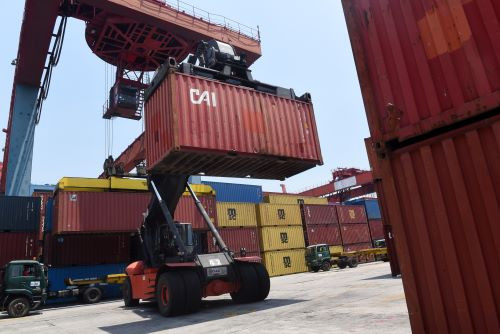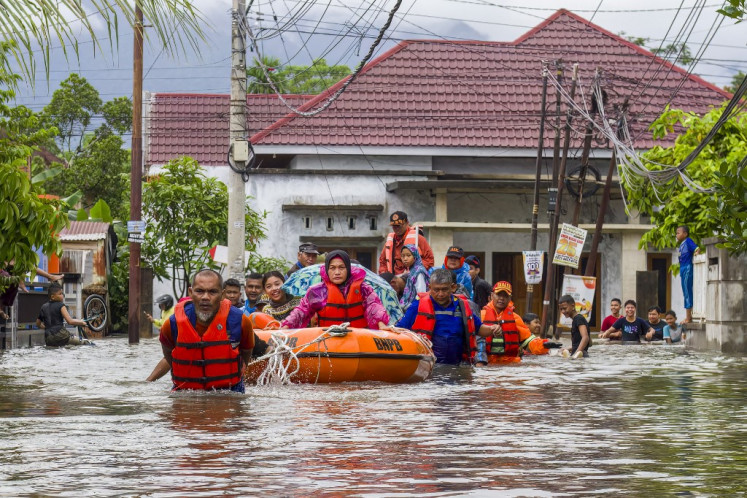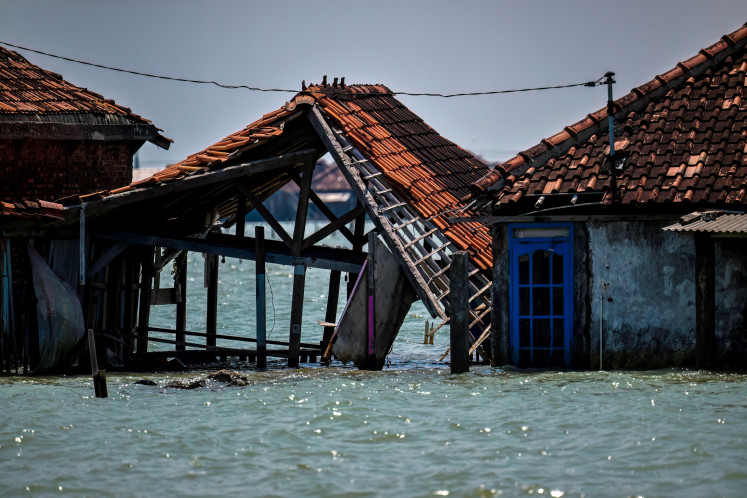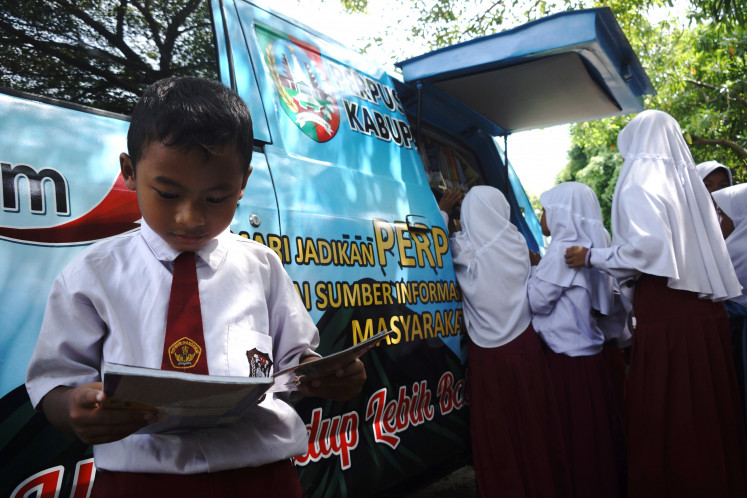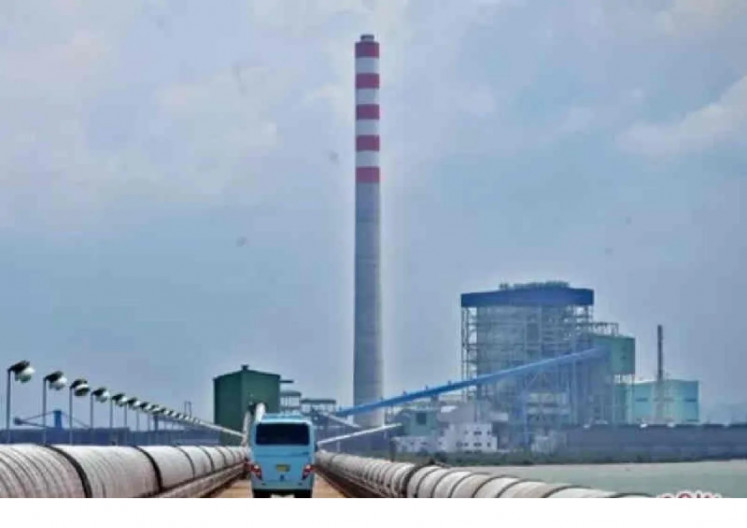Popular Reads
Top Results
Can't find what you're looking for?
View all search resultsPopular Reads
Top Results
Can't find what you're looking for?
View all search resultsTariff shock waves: Indonesia’s export strategy under fire
Indonesia must reassess its nontariff measures to address US concerns while ensuring fair trade practices and maintaining economic stability.
Change text size
Gift Premium Articles
to Anyone
J
ust when the calm of the post-Ramadan period had settled in, United States President Donald Trump dropped a bombshell: reciprocal import tariffs that cut short everyone’s well-earned break but also threatened to upend global trade with staggering losses.
Tax Foundation summarized the reason for the US’ reciprocal tariffs on imported goods at the US Congress Joint Economic Committee Hearing on Dec 18, 2024: the relative decline in competitiveness of US industries compared to other nations, widening inequality, insufficient job creation and other domestic economic issues. These concerns have driven a high-risk protectionist practice that may ultimately harm all parties involved.
The trade-balance deficit with various partners is not sufficient justification for raising trade barriers. Researchers conclude that permanent import tariffs have only a modest impact on reducing trade deficits and suggest temporary tariffs could trigger a recession, an effect that deepens if trading partners retaliate.
Although Trump’s 90-day postponement of reciprocal tariffs – followed by China after talks in Geneva – is encouraging, uncertainty persists because of the unpredictability of Trump’s directives and his questionable judgment. MacroMicro’s Trade Policy Uncertainty Index in April rose to nearly ten times its level from last September, underscoring the growing need for negotiation strategies to ensure trade stability.
There are indications that this tariff scheme was premeditated by the administration, given that the ten percent rate far exceeds the prior average tariff of two to three percent. Trump has achieved his objectives, apart from China, which has resisted pressure and compelled him to relent amid potential economic consequences—yet he frames the outcome as a victory.
In this context, the current tariff war more closely resembles Trump’s first administration policies with elevated duties that provoked retaliation and served as bargaining chips in negotiations, now applied to a wider array of countries.
During Trump’s previous term, the US steadily increased its import tariffs on Chinese goods from around three percent in January 2018 to almost twenty percent by February 2020, while tariffs on the rest of the world rose only modestly from two to three percent.
Despite these steep levies, the US trade-balance deficit with both China and the rest of the world failed to shrink. Two key factors drove this: China sidestepped US tariffs by rerouting exports through third countries such as Mexico and ASEAN nations, and US domestic industries could not fully substitute for imports; import barriers disrupted production and stoked inflation.
Despite not being as successful as fellow ASEAN countries such as Vietnam, Indonesian products supplanted Chinese goods in the US market and export-oriented Chinese Foreign Direct Investment (FDI) flowed into Indonesia. Moreover, Indonesia accelerated the signing of bilateral and regional trade agreements such as the ASEAN Plus Three and Regional Comprehensive Economic Partnership (RCEP) to diversify its export destinations and bolster supply chain resilience.
Could there be a chance to convert this disaster into an opportunity?
Learning from the limited impact of Phase One, this second salvo imposes extremely high rates on a vast array of trading partners simultaneously, an all-out effort to squeeze global imports.
The mechanics of fallout are straightforward. First, exports from nearly every country to the US will contract. Next, China’s persistent overcapacity is likely to flood global markets, including Indonesia, with surplus goods. US investors, deterred by harsher trading conditions abroad, will redirect capital back home, while rest-of-world investors chase lower-tariff jurisdictions.
China may shift more FDI toward Indonesia’s domestic market, but export-driven projects will wane. Major industrial powers could resort to dumping surpluses at cut-rate prices, and if large economies retaliate in kind, global trade volumes may plunge further, dragging down growth worldwide.
For Indonesia, the consequences are immediate and stark. The previous influx of export-oriented Chinese investment may slow while the domestic market is still uncertain. Indonesia can strengthen its trade defense and remedies in anticipation of the surge of dumping and illegal imports.
It is unclear how US tariffs on Chinese and Indonesian products will differ beyond the 90-day postponement or if Indonesia still holds the competitive advantage it once enjoyed. It is also unclear whether Indonesia can rely on substituting Chinese goods in the American market. In response, Indonesia must brace for a drop in US-bound exports of key products because of hefty reciprocal duties, and prepare for higher global production costs.
Although the outlook is bleak, there are still windows of opportunity. Exports to the US account for less than ten percent of Indonesia’s total shipments, lower than most of its ASEAN peers, hence offering greater flexibility to diversify Indonesia’s markets.
Indonesia can proactively pursue bilateral negotiations with the US, mirroring moves by other ASEAN members while refraining from retaliation.
To make a difference, Indonesia may consider initiating preferential trade agreements or bilateral limited free trade agreements with the US. Indonesia can also leverage its status under the US Generalized System of Preferences to seek a limited preferential/ free trade agreement.
Contrary to US assertions, Indonesia’s most favored nation tariffs in 2023 were moderate and applied uniformly at around eight percent. Notably, the US enjoyed a services-trade surplus of US$1.6 billion in 2023 despite a goods-trade deficit, underscoring mutual benefits that should guide bilateral negotiations.
At the same time, the Indonesian government must reassess its own non-tariff measures, since US sanctions have cited both Indonesia’s import duties and regulatory barriers. Moderating these policies with prudent review will help improve American perceptions while simultaneously addressing asymmetric liberalization effects.
In the short term, Indonesia can step in to supply goods that complement exports from heavily tariffed nations, capturing new opportunities in global supply chains.
To diversify risk, Indonesia can deepen production partnerships over the long term by attracting FDI to intermediate-goods manufacturing with countries facing lower US tariffs such as Japan and to expand its diplomatic outreach by accelerating cooperation frameworks including BRICS and the Organization for Economic Cooperation and Development (OECD).
Internally, sweeping reforms to enhance the business climate, raise productivity and lower high-cost economic structures are essential, as is an active role in World Trade Organization reform to revitalize multilateral trade.
Upgrading logistics and industrial infrastructure can target broad competitiveness rather than aligning with any single foreign investor’s supply chain, and ensure that any reexport of foreign-origin goods satisfies rules of origin requirements with substantial value additions compared to mere goods in transit. Stronger enforcement of illegal imports and more robust antidumping measures will protect domestic industries from unfair competition.
By maintaining an independent foreign policy, Indonesia can preserve diplomatic flexibility and prepare for noneconomic conditions such as domestic politics, foreign policy and defense commitments.
Negotiations are still underway, but rising tensions and disputes over key issues could drive tariffs even higher. No one knows exactly what the Trump administration has in mind. As Bob Dylan famously said, “the times they are a-changin’”. We can remain hopeful and act on what we can control.
---
Mervin Goklas Hamonangan is a junior research associate and Mohamad Dian Revindo is head of the business climate and global value chain research group, both at the Institute for Economic and Social Research (LPEM), University of Indonesia. The article is republished under a Creative Commons license.

